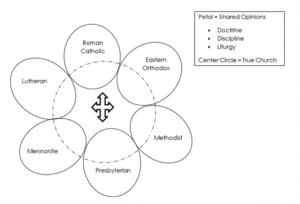
Dr. Scott Kisker
By Walter Fenton-
Dr. Scott Kisker’s recent essay on John Wesley, Methodism, and schism begins as so many often do. He quotes from Wesley’s famous sermon On Schism: “It is evil itself.” But just when we think Kisker is setting us up for another lecture on schism’s evils, his piece takes a different and refreshing turn.
Kisker, professor of the history of Christianity at United Theological Seminary in Dayton, Ohio, offers a nuanced consideration of Wesley’s understanding of the church more broadly speaking, the movements and ideas that shaped his ecclesiology, and what ramifications they might have for United Methodists today.
However, before he launches into that portion of his essay, he reminds us what is often overlooked or minimized:
“With [Wesley’s] direct and strong statement against division, it is perhaps surprising that the Wesleyan Methodist tradition has produced as many bodies of Christians as it has, some living still: United Methodist, African Methodist Episcopal, African Methodist Episcopal Zion, Wesleyan Methodist, Free Methodist, Christian Methodist Episcopal, and Nazarene, to name a few, and these only within the confines of the United States. With a global perspective, given the independence of the descendants of British Methodism and the influence of Holiness and Pentecostalism, the divisions are legion. More surprising, given Wesley’s words, than the “schisms” that flowed from our movement is the fact that our movement itself depends on schism, separation, division, for its very existence” (emphasis added).
For Kisker, it simply will not do to cite Wesley’s sermon On Schism and think that settles the matter. He asks a number of penetrating questions with the assumption that the answers will more carefully contextualize the sermon, and so better understand Wesley’s ecclesiology and thoughts on schism. In light of church divisions throughout church history, he asks:
“Where is the church in all this? What is ‘the church’ according to Wesleyan categories? Did these numerous divisions divide the ‘one, holy, catholic, and apostolic church’ or (since Wesley found the Nicene Creed too politically compromised) the ‘holy catholic church’? Were all earlier separations heretical? And which? Was Wesley a schismatic?”
According to Kisker, church unity for Wesley “does not primarily exist institutionally or even ritually in a shared sacrament of the Eucharist,” but rather the “‘oneness’ of the church is a unity through shared experience of the new birth and changed character.”
Wesley, Kisker points out, was certainly shaped by the Church of England and its Articles of Religion, and of course by the long history of the church catholic. However, as the quote above reveals, he was also shaped by Pietism, a movement more proximate to his time and place. And as Kisker notes, for Pietism “true unity in Christ was demonstrated in shared fellowship and missional cooperation across ecclesial divisions. Their ecclesiology acknowledged common cause and care across divisions of doctrine, and practice, yet did not seek to eradicate the divisions.”
As the founder and leader of the people called Methodists, Wesley borrowed heavily from Pietism, which enabled him to create a movement that found root in a variety of settings and able to make common cause with various bodies of believers. In Wesley’s sermon Of the Church, a reflection on Ephesians 4:1-6, Kisker says, he “turn[ed] aside any understanding of the unity of the universal church as primarily institutionally visible, or necessitating connection to one organization.”
To visualize Wesley’s ecclesiology, Kisker invites us to think in terms of a daisy, “with each petal being a congregation, connection, or denomination in which Christians gather. Each petal shares peculiar opinions, modes of worship, and practices of leadership and discipline that distinguish it from other ‘petals.’ The center circle, intersecting all petals, is the true church.” And for Wesley, differences among the petals or even divisions within them, cannot disrupt or fracture the unity of the true church at the center.
Kisker has five thoughtful takeaways from Wesley’ thoughts on schism in the broader context of his ecclesiology. We cannot do justice to all of them here, but suffice it to say that he asks us to do at least four things: (1) gain a deeper appreciation for the various global branches of the Methodist movement, and recognize that schism, separation, and division are a part of the movement’s lifeblood; (2) read Wesley’s remarks on schism in the context of his ecclesiology and the various movements that shaped it; (3) adopt a more humble stance about our place and impact on the church regardless of whether we remain united or separate; and, (4) recognize that “if we cannot hold each other accountable to any coherent expression of Christian ethics, if we cannot agree on explications of the General Rules, we are no longer one church, in the Wesleyan sense.”







0 Comments
Trackbacks/Pingbacks